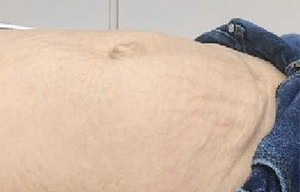
Umbilical hernias
Consultations
Why do umbilical hernias occur in adults?
The umbilicus (belly button) is formed when the umbilical cord closes after birth, leaving a relatively weak area in the abdominal wall. When extra pressure is put on this inherently weak area from inside the abdomen due to obesity, pregnancy, ascites (accumulation of fluid in the abdominal cavity due to disease), or for other reasons, an umbilical hernia can develop. It is also considered that defective metabolism (of collagen elastin, etc.) of the abdominal muscles (fascia) may be involved.
In Japan, more than 2,300 cases of umbilical hernia in adults over 20 years of age undergo surgical treatment annually, and women are 1.4 times more likely to develop it than men.


Can an umbilical hernia in an adult heal spontaneously?
Although umbilical hernias in children can heal spontaneously, an umbilical hernia in an adult cannot heal without surgical intervention.
The only treatment available for an umbilical hernia in an adult is surgical repair.
What happens if an umbilical hernia is not treated (surgically)?
Usually, the bulge at the belly button will enlarge over time, and pain may develop. Such bulging at the umbilicus may be due to intestines that protrude through the opening in the abdominal wall. When the inside of the bulge cannot return inside the abdomen, pain and nausea may develop. If this situation is not treated, it may become impossible for the protruding intestines to return through the opening. The intestines may then become strangulated, and undergo necrosis, which is a very serious situation requiring emergency surgery. Compared to umbilical hernias in children, those in adults are 14 times more likely to lead to strangulation of the intestines. Surgical repair is therefore recommended for all cases of umbilical hernia in adults, in principle.
Which treatment methods are available?
In case of a small hernia, it may be possible to close the hernia by simply stitching the two sides together. If the hernia is large, the patient is obese, or the distance between the abdominal muscles on the left and right sides is quite extensive, it may be necessary to use artificial mesh to close the opening.
【1. Using the patient’s own tissue to repair the hernia】
With this treatment method, a patient’s own tissue is used to repair the weakened area by stitching it.
One advantage of this method is that infection is less likely to develop than with a synthetic membrane (mesh) patch since the patient’s own tissue is used.
A disadvantage of the method, however, is that already weakened tissue in the area is used for the surgery, increasing the possibility of recurrence, and patients also may have stronger post-operative pain that lasts longer.
【2. Using synthetic mesh to repair the hernia】
With this treatment method, the weakened part of the abdominal wall is reinforced using a synthetic membrane (mesh) patch made of material that does not cause any problems when implanted in the human body.
Advantages of this method include a low incidence of recurrence of hernia and relatively mild post-operative pain.
Disadvantages include higher susceptibility to infection than when the patient’s own tissue is used, and post-operative pain that may rarely continue for a long time.
Surgical procedures using synthetic mesh are largely divided into two types: open repair and laparoscopic repair.
Laparoscopic repair by making small incisions at some distance from the hernia
Three or four incisions of about 5 mm are made in the abdominal wall, and special surgical instruments are inserted through these openings to do the repair.
Special surgical instruments are inserted through these openings, and a synthetic mesh patch is used to repair the defect.
The hernia is repaired from inside the body.
Which method of repair is better?
The best procedure for every patient depends on the patient’s general physical condition and the past medical history, and differs for every case.
Hernia specialists will determine the best treatment based on every patient’s individual situation.
Surgery-related statistics
Both open surgery and laparoscopic procedures are performed.
Since 2008, we have surgically treated more than 110 cases at this center. At the one-year post-operative follow-up, the recurrence rate has been 0% with the synthetic mesh method, and 1.7% for surgery not using synthetic mesh. The incidence of wound infection that required hospitalization was 3.9% with the synthetic mesh method, and 0% for surgery without using synthetic mesh. Hernia specialists perform all procedures.
